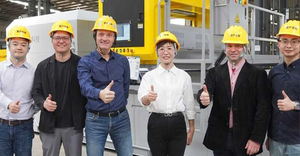Turning technology platforms built for companies like Nestlé and Starbucks into solutions for manufacturing and process industries

Editor’s Note: Veteran digital innovator Chris Brandsey was at the forefront of using web-based technologies when cloud technologies started taking shape. In his 20-year career he has used data to improve the user experience, manage supply chains, reduce costs and increase profits for multiple companies, including Nestlé and Starbucks. In this article Brandsey shares his vision for how big data can bring about step-change improvements in quality, logistics and procurement for recycling and other industrial sectors.
As a digital innovator at Nestle, my work ranged from cloud-based user applications to using automation at manufacturing facilities for the use of the internet of things (loT), with the goal of using technology for improving product quality and manufacturing productivity, as well as reducing costs. Later, at Starbucks I helped develop several key digital strategies, including the Starbucks mobile app, its digital surface strategy and the use of predictive analytics.
Today, I work in the recycling industry for a data analytics company that is striving to optimize quality management, procurement and data optimization across the supply chain – from the materials recycling facility to the paper producer. I made the move to this industry in part because I believe many of the challenges can be solved with technology, and we can have a positive impact on the environment. Here, I can mobilize market forces and the latest technologies to drive toward a sustainable future. It’s 100 percent about impact to driving change.
Around the time I started with merQbiz®, the Chinese government began restricting imports of recycled materials from the U.S. and many European countries. Quality became an important issue for us to address, and I’m always looking to use data to uncover insights, so that’s where we started.
Within the recycling sector we saw a real gap in the efficacy and transparency of data and knew we could incorporate analytics solutions to help attack the issue of fiber quality with actionable insights. We developed a solution suite for improving recovered paper (RCP), which includes a quality assessment tool that drastically reduces the time it takes to evaluate the contents of a paper bale. But the real value is in the analytics platform and dashboards that effectively visualize data patterns and insights for better decision making.
The ideas for these solutions and our current product roadmap were derived from technologies I helped develop at Nestlé and Starbucks.
Big data for specific problem solving
Most people know about the Starbucks channels (café, drive-thru and the Starbucks mobile app) from personal experience. Starbucks marketing uses machine learning to take external data (e.g., customer orders, local trends, weather) and make recommendations to the customer. For example, if it’s cold outside, Starbucks can digitally suggest hot beverage options rather than cold ones. This fits with Starbucks’ desire to connect with its customers individually. in a personalized way.
Applying this technology to the quality issue in the recycling industry, we developed an analytics platform that collects and aggregates data related to the content of individual paper bales. With insights into bale quality, recycling companies can determine how seasonal or regional climates impact moisture content in recycled materials. It can help anticipate demand for certain products based on historical trends, so sellers can better manage inventories and buyers can procure raw materials at the right time. Overall, advanced analytics can drive down costs and optimize operations for businesses across industry sectors.
However, a challenge in any industry is determining the appropriate data inputs at the outset. Companies often have processes that either aren’t digitized or not digitized in the correct manner to capture useful data. By running the data through deep analysis, we can determine what to measure and where opportunities exist to tackle specific problems.
Data tracking in the cloud
I was fortunate to work for companies that were early to embrace connected devices and big-data analysis. Many retailers like Starbucks focus a tremendous amount of effort on understanding customer trends and purchasing behaviors, and then using that information to increase customer count and how much customers spend. This knowledge stems from analysis that was done based on data collected from connected devices such as point of sale (cash registers) and mobile-ordering technology.
Manufacturing and process companies are still figuring out how to implement Industry 4.0, with systems interconnected on the industrial IoT. Fortunately, this can be approached with pilots, which is how Nestlé tackled the challenge. The sooner companies transition to this methodology, the faster they can take advantage of centralized information, dashboards and data analytics.
Operationally, recycling centers with cloud connectivity will be able to collect data at every stage of their process, leading to valuable insights for optimization and more informed business decisions. Our business is in data models and building the appropriate models to answer the most pressing questions within the recycling industry.
For example, looking at data on incoming materials can help determine the source of contaminants. Companies can discover variances in sorting processes and quality control by facility.
Another question we are seeking to answer for our customers is how the quality of the recovered paper material impacts the quality of the finished product. In addition, customers can use predictive models to streamline raw material purchasing decisions, leading to cost reductions of up to 8 percent, according to a McKinsey study on the benefits of introducing predictive analysis into procurement operations.
Customers can enable all these business insights by cloud technologies, connected devices and robust data analysis. And that’s just the beginning.
Supply chain management
Supply chain optimization is another area where big data has proven invaluable. The typical supply chain is cumbersome, slow and costly with lots of moving parts Customers can drastically improve these processes with the right technology.
At Starbucks, we deployed a supply-based management program that established visibility of products supplied around the world. By capturing the right data in unique ways and driving it through our predictive analytics, we were able to reduce food safety issues by 98 percent in just one year.
With the application of big data analytics, cloud technologies and connected devices, we can easily enable significant cost reduction efforts across a company’s supply chain -- shining a light on areas of cost reduction, increased profits, decreased claims and production acceleration.
What it takes to get there
Organizations of all sizes, industrial and consumer, need to have an innovation arm to determine how technologies can land in their facilities and in the market. When I look back at my career at Nestlé and Starbucks, not everything we created was deployed, but the development experience and lessons learned were incredibly valuable.
As a data-first company, merQbiz has built a platform that enables us to help companies embrace technology with pilot programs that are relatively cost effective. Executing digital technologies in a business environment often requires large transformation and change management efforts across an entire organization.
As we were building our BaleVision™ quality solution, we were focused on being able to deliver a digital technology that was plug-and-play into the ecosystem of a business, thus removing the need for corporate transformation. We built data visualizations (dashboards) to quickly connect with the customer’s data set, run analysis and provide insights based on their needs.
Additionally, the infrastructure we have put in place allows for rapid prototyping, so recycling companies and paper producers can run multiple pilots simultaneously, even starting small at a single facility. We pride ourselves on being able to generate data products very rapidly for our customers, thus answering their most pressing questions about operations, procurement, logistics and quality.
Industries all over the world are successfully using a variety of systems and devices that have created a radical shift in the way they operate. We can borrow from those successes to animate traditional industries.
For manufacturing and industrial sites to thrive in the coming years, they will have to embrace technological advancements. Companies must get comfortable with strategic change and understanding the pulse and needs of the customer. Just as Starbucks and Nestlé have established dominance through high-tech operations, industrial businesses can do the same.
Christopher Brandsey is chief product officer responsible for product development, engineering and data science at merQbiz®, a Los Angeles-based data analytics company in the recycling industry.
About the Author(s)
You May Also Like




